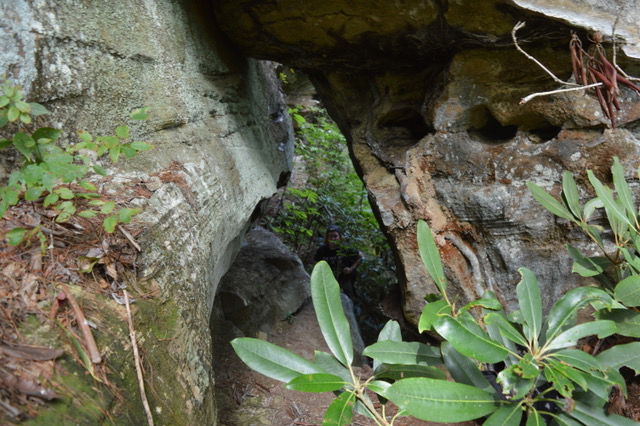
How Long Have Arches Been Around?
The recent collapse of many arches is a problem for evolution.
Several friends and colleagues sent me links to news accounts of the collapse of Double Arch in the Glen Canyon National Recreation Area on August 8. There have been similar collapses of arches in nearby Arches National Park, such as Wall Arch in 2019 and Rainbow Arch in 2018. It’s difficult to get good statistics on the rate at which Utah is losing arches. An article published in 2000 said that since 1971, at least 43 arches in the park had collapsed. Why did the article say, “at least 43 arches” have collapsed over those 29 years? Arches National Park has at least 2,000 arches, but the exact count is not known. Visitors to the park are familiar with the large arches, but most of the arches are small. We can be assured that all the large arches have been found, but some small arches have escaped discovery. People notice when large or otherwise well-known arches collapse. However, many small arches (some unknown) probably have collapsed, but no one noticed. Therefore, we can consider the collapse of 43 arches in 29 years a conservative loss rate.
People notice when large or otherwise well-known arches collapse. However, many small arches (some unknown) probably have collapsed, but no one noticed.
Utah has more arches than any other state. Kentucky is number two. But Kentucky isn’t losing arches as Utah is. I have never heard of an arch in Kentucky collapsing. For instance, consider Kentucky’s Red River Gorge, where I spend much of my free time. Answers in Genesis sponsors field trips in Red River that I lead. Red River is second only to Arches National Park in arch count. No one knows how many arches are in Red River, but it’s probably more than 1,000 (I’ve seen more than 330 in the gorge so far). There has been no recorded arch collapse in Red River Gorge. Given the spate of collapses of arches in Utah in recent years, most parks in the West that feature arches forbid people from climbing onto the arches, perhaps more to preserve arches than to save lives. With no known arch collapses, there are no such restrictions in Kentucky.
Come to think of it, not only is Kentucky not losing arches, but the number of known arches in Kentucky is increasing with the discoveries of previously unknown or at least undocumented arches. For instance, just four days after Double Arch in the Glen Canyon National Recreation Area collapsed, my hiking buddies and I found two new arches in Red River Gorge (see photos). Why are Kentuckians finding new arches? Unlike the desert West, the lush vegetation in the rugged landscape where arches are found in Kentucky masks arches from view. Often one must be standing next to an arch to see it, and even then, it can be difficult to spot. At the rate Kentucky is gaining arches and Utah is losing them, perhaps Kentucky eventually will overtake Utah in being the state with the greatest number of arches.


Why are Kentucky arches more durable than Utah arches? It probably has to do with the cementing agent of the respective sandstones. The cementing agents in the Navajo Sandstone, in which Double Arch was, are calcite or silica. Calcite and iron oxide are the cementing agents in the Entrada Sandstone, in which the arches of Arches National Park are found.1 Calcite is water soluble, and the presence of any acidity of water, such as naturally occurring carbonic acid from rainwater, erodes calcite. This probably explains why Utah’s arches are so prone to collapse—the cementing agents holding the rock together are eroding. On the other hand, many of Kentucky’s arches are in the Corbin Sandstone, which is cemented by silica, infilled with hematite and clay minerals.2 Those are not nearly as soluble in water, nor are they as affected by acid as calcite is.
How Old Are Arches?
The collapse of Double Arch got me thinking of whether the rate of arch loss in Arches National Park might indicate something about the maximum age of the arches in the park and perhaps how rapidly arches form. Most people tend to think that natural geologic features form very slowly and endure for a long time (i.e., uniformitarianism beliefs). However, much of the literature about Arches National Park says that its arches last for thousands of years, not millions of years. The theme is that erosion continually forms and collapses arches, implying that there is a sort of steady state in the number of arches. But if that were the case, wouldn’t we see small openings in rocks developing into openings large enough to be recognized as arches (depending on whom you ask, the minimum opening size in at least one direction is either three feet or one meter)? If there is a steady state in the number of arches, wouldn’t we expect documentation of new arches being formed? It doesn’t appear that anyone has documented the recent formation of an arch, suggesting that the number of arches in Arches National Park is declining rather than being in a quasi-steady state. Therefore, we might expect that eventually there won’t be any arches left in Arches National Park. How do we go about figuring out how long before the arches are gone?

The exponential model prediction of the number of arches in Arches National Park as a function of time. The zero year is 1971, with positive years after 1971 and negative years prior to 1971. For instance, -1,000 years corresponds to the year AD 971. Image by Rob Webb.
Taking the loss of 43 arches over 29 years as a good measure of the rate of arch loss, that is an average of 1.48 arches lost per year. If the count of 2,000 arches is accurate, then extrapolating the current loss rate of 1.48 arches per year, one would expect that there would be no arches left in about 1,350 years. However, the assumption of a constant (linear) rate of arch collapse is not the correct way to determine when there would be no arches left in Arches National Park. When there are more arches, the collapse rate ought to be higher than when there are fewer arches, so the rate of collapse ought to decrease over time. In science, we are very familiar with this sort of varying rate of change, and it is best described by an exponential function. What is an exponential function? It uses the number e, the irrational number approximately equal to 2.718, which is the base of natural logarithms, raised to a power of time. We will express time in years. Let N0 be the number of arches at some time, with that time defined to be zero. The number of arches at any other time, N(t), will be
where λ is the decay constant. What is the numerical value of the decay constant? We can use the current observed rate of arch loss to determine what the decay constant is. Let N1 be the number of arches at t1 and let N2 be the number of arches at time t2. Then applying the exponential function, we get
and
Dividing the second equation by the first equation and taking the natural logarithm of either side, we get
which reduces to
Taking N2 to be 2,000 arches in the year t2 = 2000 and N1 to be 2,043 arches in the year t1 = 1971, the decay constant λ = 7.34 x 10-4 yr-1, with the reference year zero being 1971. The simple but incorrect linear analysis above yielded no arches in 1,350 years, but the more realistic exponential decay analysis yields 758 arches in 1,350 years, a loss of more than half the arches that we have today by the year 3320.
How do we estimate the number of arches that existed in the park in the past? We can do that by inserting negative time into the equation. A thousand years before the reference year of 1971, the number of arches would have been 4,256. That is, more than 2,000 arches were lost over the past millennium. But two thousand years earlier, there would have been nearly 8,900 arches, nearly five times as many arches today. Given the measured loss of arches in Arches National Park over the past half century, these appear to be reasonable numbers. But keep in mind that this is an exponential decay—the numbers decline more gradually into the future, but they have declined more rapidly in the past. Just a little more than 8,400 years ago, the number of arches would have been a shocking one million! Of course, no one believes that—there would have been more than 8,000 arches per square mile of Arches National Park, and large portions of the park don’t have arches and probably never did, meaning that the density of arches in the part of the park with arches was far higher. This is why the National Park Service says that the arches in Arches National Park last only thousands of years, not millions of years. But 8,400 years is just “thousands of years” too. I’m sure that most people understand the “thousands of years” to be tens of thousands, if not hundreds of thousands, of years, not less than 10,000 years.
We know that the flood recorded in Genesis was about 4,500 years ago, in which the rocks Utah’s arches are found were laid down. So, starting with a biblical worldview, this means that the arches formed sometime after the flood, and thus the arches must be younger than 4,500 years. Taking 4,500 years as the maximum age of the arches, the measured exponential decay of arches yields about 50,000 arches, but keep in mind that this is an upper estimate—since the arches formed sometime after 4,500 years ago, the original number of arches in the biblical timeline would be less than this. This upper limit to the estimate is about 25 times the number of arches presently in Arches National Park. Though high, this is a reasonable number.
Conclusion
While arches in Utah are observed to be collapsing, there is no evidence that arches are forming there today.
While arches in Utah are observed to be collapsing, there is no evidence that arches are forming there today. This does not preclude arch formation today, but it indicates that the destruction rate of arches exceeds the rate of arch formation. The formation rate of arches today is probably minimal, not enough to sustain a steady number of arches. A simple exponential fit to the measured loss rate in Arches National Park results in a maximum age that is consistent with the biblical account of the flood, but it is at odds with the assumption that the arches are much older.
Answers in Depth
2024 Volume 19
Answers in Depth explores the biblical worldview in addressing modern scientific research, history, current events, popular media, theology, and much more.
Browse VolumeFootnotes
- Hellmut H. Doelling and Paul A. Kuehne, “Geologic map of the Windows Section 7.5' quadrangle, Grand County, Utah,” Utah Geological Survey, 2013, https://geology.utah.gov/publication-details/?pub=M-260dm.
- Robert Thomas Lierman, “Cementation History of the Corbin Sandstone Member of the Grundy Formation (Lower Pennsylvanian) in East-Central Kentucky,” Sedimentary Geology and Paleontology, Southeastern Section, 54th Annual Meeting (March 17–18, 2005), Geological Society of America Abstracts with Programs 37, no. 2: 38, https://gsa.confex.com/gsa/2005SE/webprogram/Paper83453.html.
Recommended Resources

Answers in Genesis is an apologetics ministry, dedicated to helping Christians defend their faith and proclaim the good news of Jesus Christ.
- Customer Service 800.778.3390
- Available Monday–Friday | 9 AM–5 PM ET
- © 2026 Answers in Genesis


